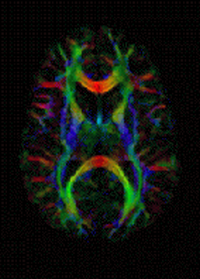An MRI for Migraine?
So this is a “holy grail” of migraine diagnosis – that is, something that we’ve always wanted to be able to do. But – we haven’t quite found it yet. Or have we?

Let me explain. When a patient comes into a doctor’s office with a broken arm, the doctor can check how your muscles and joints are working, ask you where the pain is, and even take an x-ray. The result is pretty straightforward – you have a broken arm.
But migraine – and remember, there are various types of migraine, and migraine is only one type of headache disorder – is entirely different. Your doctor relies mostly on what you say (especially if you’re not in the middle of an attack right then) – how you describe the pain, what other symptoms you’ve noticed, and so on. They don’t generally give you a scan, or take a blood test.
Don’t blame your doctor for this – these tests wouldn’t usually be of any help, and in some cases might do more harm than good.
Migraine is a complicated disease. We don’t entirely understand why an attack happens. And although we’ve learned a lot about what happens in the body when an attack takes place – we can indeed see certain things happening with various types of technology – we still don’t understand why some people have migraine and others don’t. We have a lot of ideas, theories, and clues – and even a lot of knowledge – but we don’t have the whole picture.
So researchers are still trying to find a way to do test of some kind – to look at something in your body – that will tell them – yes, this person has migraine. Better yet, this person has this type of migraine. That way we would be able to get to the best treatment for you ASAP.
One of those bits of research was just published in June. It involved a type of MRI scan (magnetic resonance imaging scan) called diffusion-weighted imaging (DWI).
DWI is a type of scan that can “see” where water molecules are. Here, let’s let Dr. Alexander Mauskop from the New York Headache Center explain:
The researchers used diffusion MRI, a technique that focuses on the movement of water molecules within the brain’s tissues (fMRI measures blood flow to different areas of the brain). It is particularly useful for mapping the brain’s white matter tracts, which are the pathways that connect different brain regions.
Another MRI study attempts to diagnose migraine
So, as you would normally do in a study like this, they took patients with migraine, and patients without migraine, and compared the two. And yes, there tended to be a difference. Back to Dr. Mauskop:
Significant differences were found in brain regions such as the orbitofrontal cortex, temporal pole, and sensory/motor areas.
Another MRI study attempts to diagnose migraine
Changes in connections between deeper brain structures (like the amygdala, accumbens, and caudate nuclei) were also noted.
Using machine learning, the researchers could distinguish between migraine patients and healthy individuals based on these brain connectivity features.
That sounds pretty amazing, and it actually is. One of the beauties of computer technology is that computers can play with huge quantities of numbers – lots of data – and quickly compare things in a way the human brain can’t.
But don’t run to get your head scanned yet. Your doctor will still probably get a more accurate diagnosis by talking to you. Why?
First, this was a fairly small study. Will this difference continue in other groups of patients? Why the difference? Would there be a difference between patients with migraine and other different headache conditions? Or other conditions in general? And even if we can accurately predict that a patient has migraine, will this be more accurate than a well-informed specialist and a patient who communicates?
We hope that this research will continue, because it would have huge benefits. Meanwhile, instead of getting your head scanned, make sure you have a doctor who takes the time to talk to you. Consider a headache specialist. And watch your symptoms closely – tell your doctor what you’re experiencing, and be sure to share your medical history. Becoming adept at these things today will in most cases do a lot more than having a scan.



